This post may contain affiliate links. By clicking and making a purchase through the links, I earn a small commission at no extra cost to you. See my disclaimer for more information. This and display ads allow me to keep the site up to date and give back.
One of the greatest things about a trip to Colombia is there are so many places to go to have an adventure. Whether hiking alongside the giant wax palms of the Cocora Valley outside of the quaint mountain town of Salento, exploring the Amazon, whale watching in the Pacific, taking in the amazing Chicamocha Canyon outside of seemingly stuck in time Barichara, or exploring the desert of La Guajira, there is a ton to see and do in the country. That’s not even mentioning the big cities like Medellín, Bogotá, and Cartagena!
One adventure you won’t want to miss in Colombia is visiting the amazing landscapes and undeveloped beaches of Tayrona National Park aka Parque Nacional Natural Tayrona. It is perfect for a two or three day trip from Cartagena and is located near a cluster of nice places to visit along Colombia’s northern Caribbean coast.
Getting to Tayrona National Park
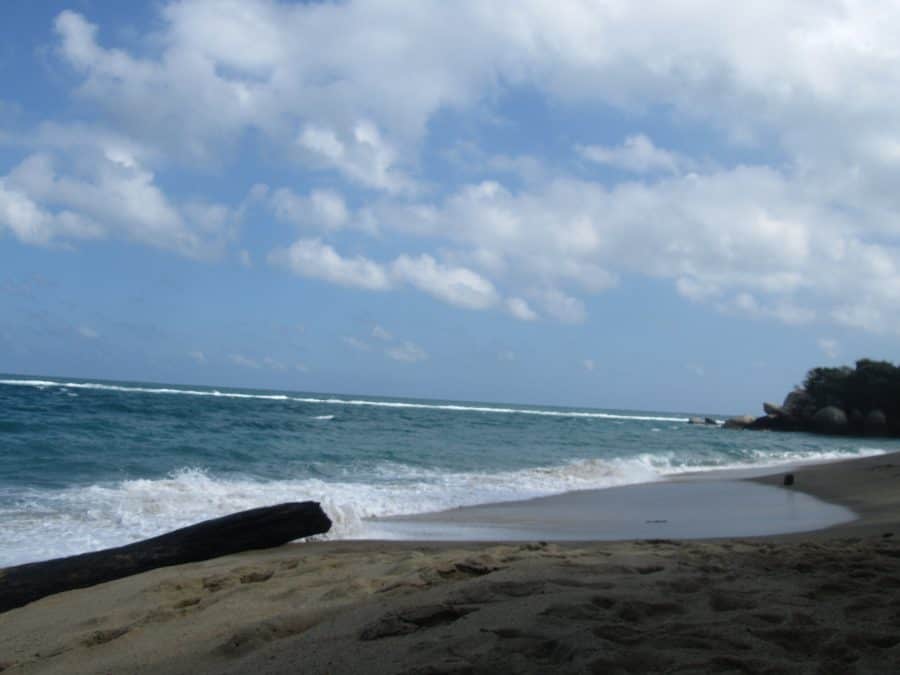
If you’re coming from the south, the easiest and most budget-friendly way of getting to Tayrona is by getting to the city of Santa Marta first and then taking the bus. If you’re coming from Cartagena, the charter bus service Marsol does offer a direct bus to Tayrona but on a limited schedule.
Marsol and competitor Berlinas offer numerous buses throughout the day from Cartagena to Santa Marta. You can also get a bus from the terminal in Cartagena, although it is a good ways out of the way and expensive taxi ride away from the main tourist area.
From other cities in the interior of Colombia, you should be able to get buses to Santa Marta or Cartagena. Do note that buses from the interior to the coast are long trips, so you may want to fly into the airports in Cartagena or Santa Marta depending on how much time you have. Search on Skyscanner to find the best flights.
Once in Santa Marta, you’ll want to get the bus to Tayrona from the market in downtown Santa Marta. You’ll see Tayrona along with Palomino and Riohacha listed in the front windshield. You can also book a shared shuttle online that will pick you up at your hotel. Many travelers also take the bus from Minca to Tayrona, which is a beautiful mountainous town near Santa Marta (you can learn more about it in my Northern Colombia guide).
The bus takes from 90 minutes to 2 hours to reach the park, depending on how many stops it makes. Expect it to be crowded with many locals carrying their goods from the market.
The bus almost always stops outside the main entrance to the park known as El Zaino. The sparring, the guy who collects the money, will give a shout. If you want to be extra sure you don’t go past the park, don’t be shy about asking him or another passenger to let you know when the bus is outside the park. My experience has always been that locals are more than happy to help.
If you are coming from the north, you can catch the same bus on its way back from Riohacha. It passes along the main road just outside of Palomino.
Finally, you can also take boats to Tayrona from the town of Taganga, although seas can be choppy, so I would only recommend doing the boat if you are seriously pressed for time and can only do a day trip. Definitely avoid it if you are uncomfortable on boats or bouncing up and down on the waves.
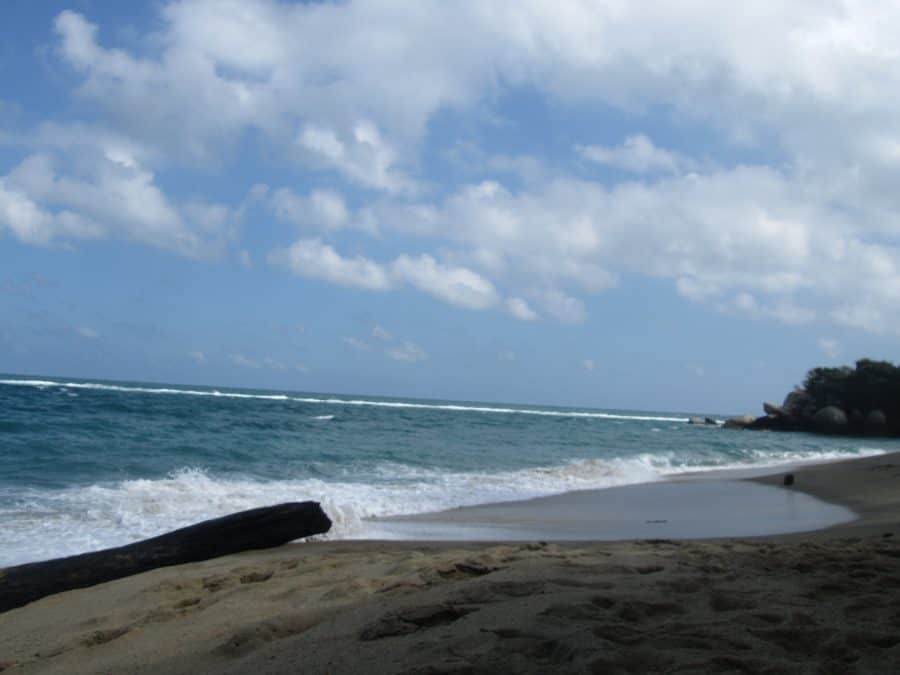
Tayrona National Park Accommodation
Most visitors stay at the campsite at Cabo San Juan del Guia, about a two and a half hour hike from the main entrance to the park. A small cape where a rock formation creates a little bay as well as another nice beach on the other side, it has hammocks and tents for rent. Visitors can also bring their own tent and pay to rent the space for it. Finally, there are a limited number of cabins for a considerably higher price.
Tayrona National Park Hammocks
The Tayrona National Park hammocks are under a covered area and are the best option if you are visiting during the rainy season from October-December. If you want to pay a little more, you can also get a hammock atop the rock formation and the great view it comes with.
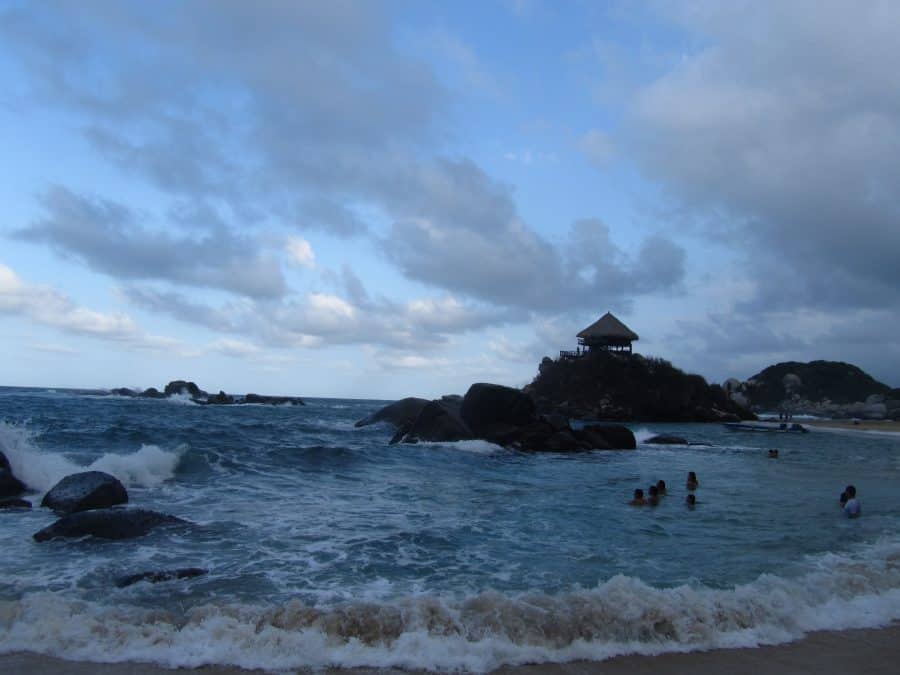
Tayrona National Park Amenities
All the Tayrona National Park accommodation options at Cabo San Juan include access to the bathroom and shower facilities. They are pretty decent for communal, campsite bathrooms and showers. Do be aware that there can be long lines for the shower at peak times, like just before dinner.
Speaking of dinner, there is a small restaurant on site as well. They serve up typical Colombian chicken and fish plates that come with rice, patacones (fried plantain patties), and salad as well as pastas and a few other options like shrimp and seafood rice. There is a vegetarian pasta option as well. Prices are typically in the 25-35,000 pesos range.
There is also a small store in the park. You can get snacks and some nonperishables like cans of tuna as well as beers, water, coffee, and sodas here. Visitors are not technically allowed to bring in alcohol, although some sneak it in.
You are, however, allowed to bring in water, and you will definitely save some pesos if you stock up with a big jug at the little store just outside the main entrance to the park rather than buying it in the park itself. Single use plastics, including single serving plastic bottles, were barred from Colombia’s national parks in 2020, so make sure it is one of the larger bottles or jugs.
There is also sometimes a sandwich vendor that sells some tasty sandwiches at Cabo San Juan, and there is a terrific little bakery you go past on the hike in if you want to pick up a few breads for your breakfasts or dinners to save a bit on the restaurant. You can’t make fires inside the park, so don’t plan to do any cooking.
Alternative Tayrona National Park Accommodation
For other options for where to stay, there are expensive glamping style cabins at the Ecohabs resort inside the park as well as a beach hostel at Playa Brava, which is only reachable from the alternative Calabazo entrance to the park.
Finally, you could choose to stay at a handful of hostels and lodges located just outside the park. You will have to make the 2+ hour hike in and out the same day, but you may be able to save a bit on accommodation and food that way.
Lora’s rec: I spent a night at Viajero Tayrona Hostel and Ecohabs which offers beautiful and affordable accommodations right on a beach. This place felt like a resort but has hostel dorm rooms so it’s priced affordably. There wasn’t much of a social vibe going on while we were there, but it was a perfect place to relax for a night.
If you want a social and fun place to stay, go to El Rio hostel. This unique hostel is nestled in the Colombian jungle alongside the Buritaca river. This hostel is wildly popular with backpackers and was voted the best hostel in Colombia. There’s no wifi here so prepare to disconnect and make a ton of new friends.
What to Do While Visiting Tayrona National Park
Hiking through beaches in Tayrona National Park
Hiking through the amazing landscape and enjoying the beautiful beaches are really the prime attraction of a visit to Tayrona.
On the hike in, you’ll get some really great views of the beaches and rock formations formed by the foothills of the Sierra Nevada mountains and their never-ending fight with the sea.
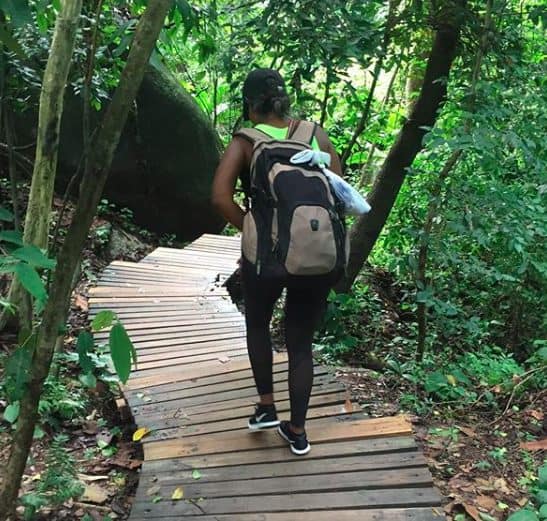
The first beach you come to after hiking down out of the hills is called Arrecifes. In fact, you have to hike along a wide stretch of this beach. Riptides make it extremely dangerous, so swimming is not permitted here.
After another short time hiking through the forest, you will come to another series of beaches. Here you can swim. The best beach here is known as La Piscina, where rocks offshore serve as a buffer to the waves and create a natural swimming pool.
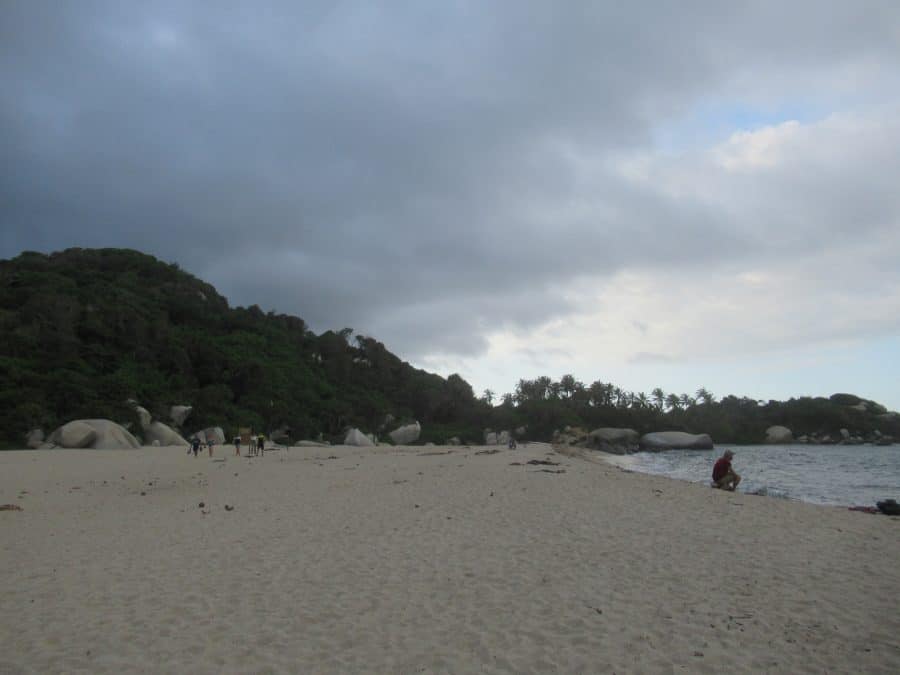
A bit further on from that is Cabo San Juan, where the beach is pretty decent. If you’re not staying there, you can pay a small fee that gives you access to the bathrooms and hanging out at the beaches.
About 20 minutes past Cabo, you’ll find another nice beach. This is actually my favorite beach in Tayrona, as it is a nice long stretch of beach and there is usually hardly anyone there, despite it not being far away. Do note that the waves here are quite rough and that nudity is allowed at this beach (in my experience most people do not actually go in the nude), so keep those things in mind.
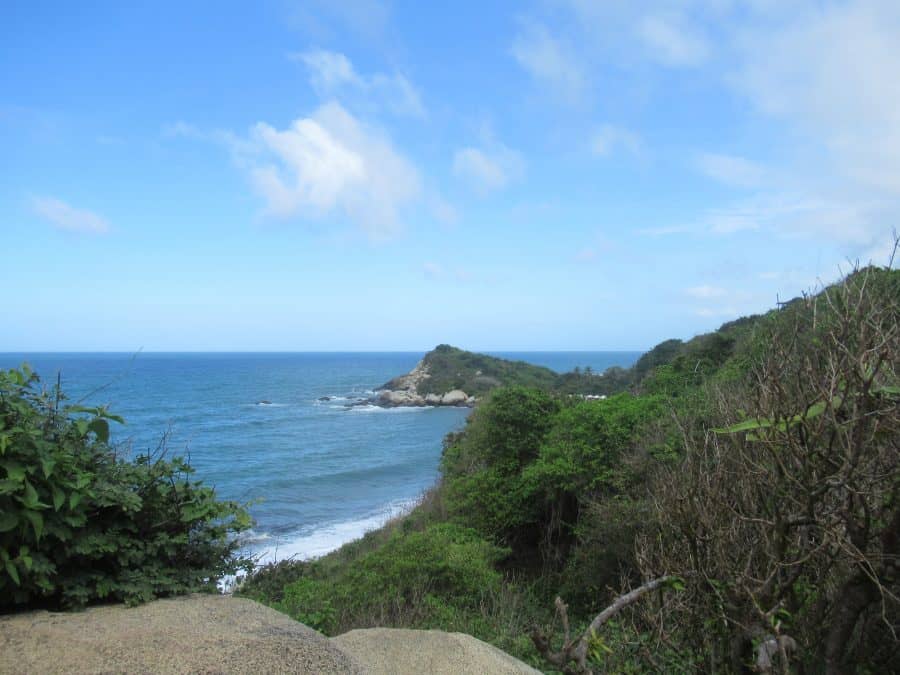
There is a path up to a small indigenous town known as Pueblito above Cabo San Juan, however it was closed in 2019 at the request of the town’s inhabitants. This path also was the route to hike to Playa Brava, so with its closure, you can now only reach Playa Brava from the Calabazo entrance to the park.
While in the park, be on the lookout for wildlife. There are tons of bird species, and if you’re lucky you might spot a sloth or some monkeys. Every now and then crocodiles are also spotted near the water, so keep an eye out for them too!
Diving Tayrona National Park
Lora’s rec: You can also go diving in Tayrona National Park, and the water is spectacular. After learning to dive in Utila, I was hooked on the sport and quickly did my advanced diving certification in nearby Taganga. Many of the dive sites we visited were inside Tayrona National Park.
You won’t see many big marine animals in the water here, but the ocean is abundant with beautiful colorful corals and small marine life. You can see lionfish, angelfish, lobsters, moray eels, sponges, anemones, and more. The best part about diving in Tayrona National Park is that you get to enjoy the beautiful beaches during the surface intervals!
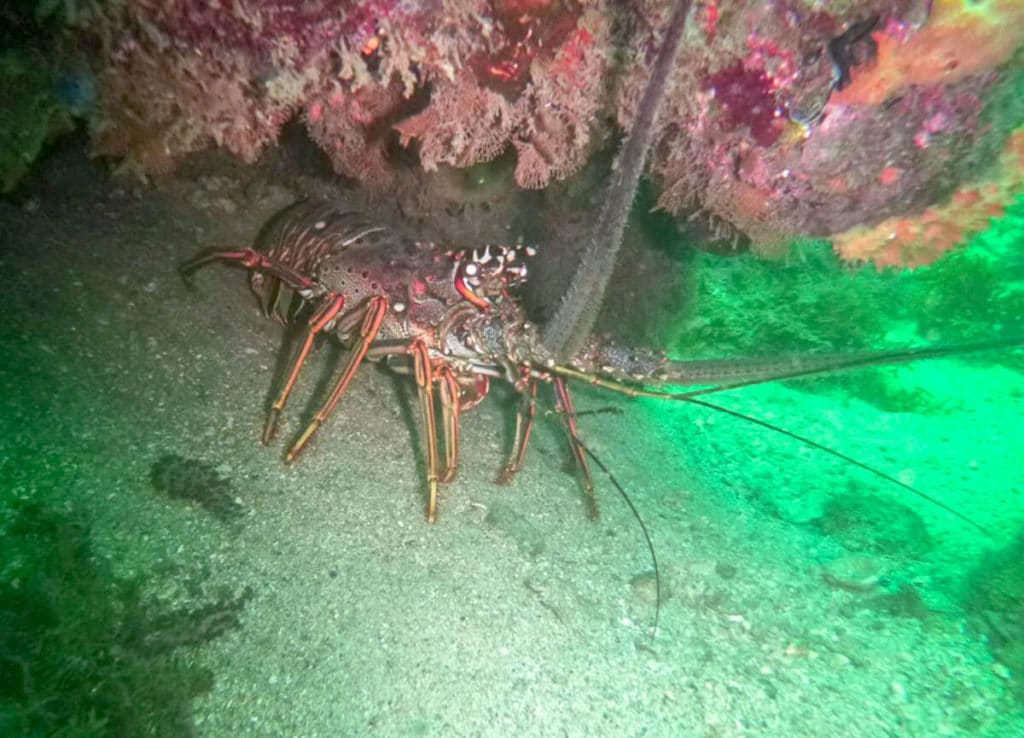
Aside from that, take along a good book and spend some time enjoying being out in nature and fresh air. Visiting Tayrona National Park is a great chance to get away from it all and disconnect for a few days, so take advantage of it!
Tips for Planning a Trip to Tayrona National Park
- The park closes several times a year. Usually, this is for the entire month of February as well as a week or two each around mid-year and in October. Double-check that the park is open before planning your trip.
- You will want to pack plenty of sunscreen as well as bug spray. A pair of jeans and a light jacket is also a good idea, as the breeze can get surprisingly chilly at night sometimes. Check my day hiking essentials packing list for ideas on what to bring.
- Keep in mind that the indigenous Kogi people consider the area sacred. Respect them and take care of the park by not littering.
- Knives are not allowed in the park.
- Since the hike in and out takes a good bit of time, you’ll want to make sure you enter the park and start your hike out when you leave by mid-afternoon to beat sundown.
- If you have heavy bags, you can hire horses to carry your bags for you in or out of the park. You can also save a bit of time on the hike by catching a small van from the entrance to the parking lot for a nominal fee when you enter the park.
- I recommend a budget of about 150,000 pesos a day, which should be plenty to pay for accommodations at Cabo, food, and buy a few beers. If you plan to buy a lot of beer or want to splurge on food, take along a bit more.
This post was written by Adam McConnaughhay. He has lived in Cartagena, Colombia since 2011. In addition to working as a school teacher, he also writes about Cartagena and other places in Colombia at CartagenaExplorer.com.
Enjoyed this post? Pin it for later!



Leave a comment